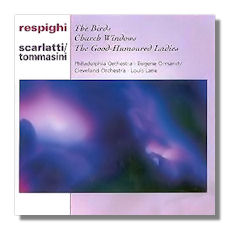
The Internet's Premier Classical Music Source
Related Links
- Respighi Reviews
- Latest Reviews
- More Reviews
-
By Composer
-
Collections
DVD & Blu-ray
Books
Concert Reviews
Articles/Interviews
Software
Audio
Search Amazon
Recommended Links
Site News
 CD Review
CD Review
Ottorino Respighi

Suites and Ballets
- Ottorino Respighi:
- The Birds (Gli uccelli)
- Church Windows (Vetrate di chiesa)
- Scarlatti-Tommasini: The Good-Humored Ladies *
Philadelphia Orchestra/Eugene Ormandy
* Cleveland Orchestra/Louis Lane
Sony SBK60311 63:47
Summary for the Busy Executive: Italian good humor.
Ottorino Respighi, with his Roman trilogy (Pines of Rome, Fountains of Rome, and Roman Festivals) is probably the most popular modern Italian composer after Puccini. He studied both in Italy and in Russia, the last with Rimsky-Korsakov, who helped him refine his orchestration.
Respighi's music falls into four categories. The earliest resembles the music of other Italian composers of his time, or slightly before, like Martucci, who had taught Respighi composition in his senior year at the conservatory. He becomes musically influenced mainly by Debussy, but with a touch of Richard Strauss as well. However, the intellectual currents in Italy move his music in significant new directions. Italian music (and art in general) had entered a crisis phase as early as the retirement of Verdi. Italian composers, instead of writing naturally, began to ask what it meant to create specifically Italian art. Italianitè – "Italianness" – became a conscious goal for composers with significant stylistic differences, from writers of verismo opera to the few followers of Stravinsky. Respighi began to explore the Italian musical past in his own way, going through a period influenced by Renaissance lute and keyboard works. He also feels the influence of Gregorian chant, and this results in yet another, extremely rich creative strand.
The Birds (1928) continues the approach of the Ancient Airs and Dances for the Lute, begun in 1917. In contrast to the Roman trilogy of the Teens and Twenties, Respighi has pared his orchestra down. Individual colors dominate, rather than tonal masses. This results in textures of gorgeous delicacy, elvish dances, far more memorable and moving than most orchestral wallows. Church Windows, from 1926, is an elaboration of the Three Preludes on Gregorian Melodies for piano (1921). Respighi's impetus here is primarily pictorial, and this results in a musically-diffuse work compared to the preludes. However, the sound is so gorgeous, I'd feel like an ingrate if I complained.
Vincenzo Tommasini (1878-1950), a Respighi contemporary, fell under the spell of Debussy and wrote one of the first important articles (1907) on that composer. He's not nearly as well-known as Respighi, of course, and indeed only one work keeps his name alive: the score for the Diaghilev ballet The Good-Humored Ladies, orchestrations of Domenico Scarlatti keyboard works. This scored a huge success and helped pave the way for a host of similar ballets, including Stravinsky's Pulcinella. Tommasini, reclusive by nature and unencumbered by the need to make money, essentially fled his fame, failing to market his music, although he continued to compose. Based on this ballet, I'd like to hear more. The orchestration may not have Respighi's poetic flair, but it certainly keeps the pot bubbling. On the whole, the score lives up to its title.
Eugene Ormandy played this kind of stuff with genius. He could magically transform fluff to gold, and he certainly does so here. The Philadelphia shines in this music. Indeed, Ormandy and Doráti are probably my two favorite Respighi conductors. Ormandy's Birds to me has reached the status of a classic recording. Louis Lane, on the other hand, has to a large extent been hidden in the large shadow of George Szell, but he's an interesting conductor in his own right. In the days when he was recording for Columbia/Epic, I used to greet the appearance of a new Louis Lane LP with pleasurable anticipation. The repertoire always got my attention, and the performances both moved and delighted me. I've known this Tommasini recording for years and rejoice that it's returned to the catalogue. As far as I'm concerned, three enchanting readings.
This disc also belongs to the series of reissues from ArkivMusic. The company has licensed recordings, many of them personal grails for collectors, from major labels, both active and defunct, and produces discs on demand. Presently, they have slightly under 6,000 items in their catalogue. Each CD comes with original artwork, but not necessarily liner notes. My copy had none, although I've read that you can order the notes at additional cost through www.arkivmusic.com. The prices are generally mid-range, but if you can find a copy cheaper, either second-hand or through places like Berkshire Record Outlet, don't let me stop you.
Copyright © 2008, Steve Schwartz



















